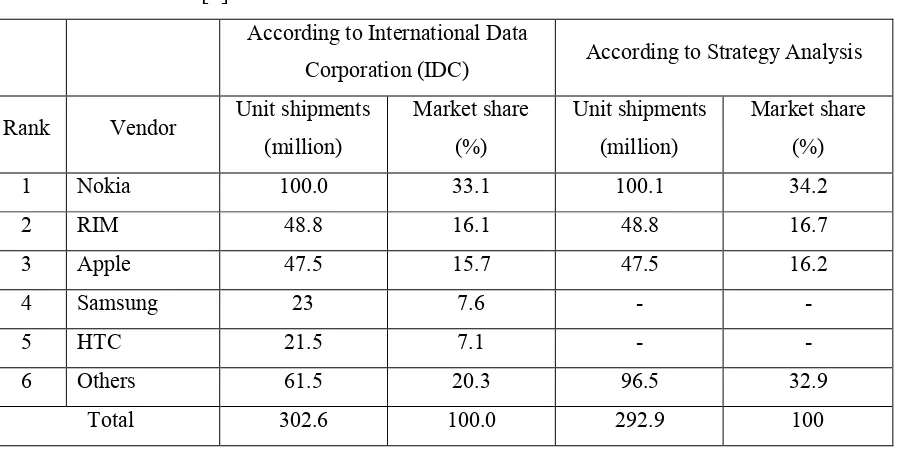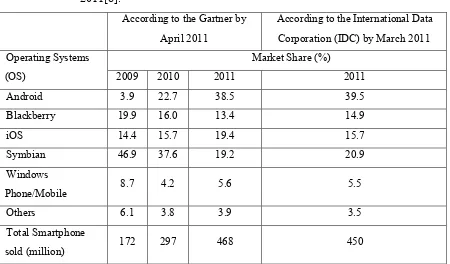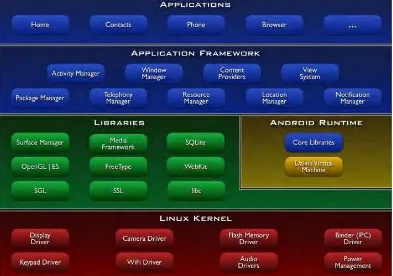i
DEVELOPMENT OF FORGET ME NOT ON ANDROID APPLICATION BY USING BLUETOOTH COMMUNICATION TO SECURING DIGITAL DATA IN
UNIVERSAL SERIAL BUS (USB) DEVICES
Mohd Rahim Bin Ab Rahman
i
I hereby declare that I have read through this report entitle “Development of a Forget Me Not (FMN) on android application by using Bluetooth communication to securing digital data in Universal Serial Bus (USB) devices” and found that it has comply the partial fulfillment for awarding the degree of Bachelor of Mechatronics Engineering with Honours.
SIGNATURE : ………
SUPERVISOR’S NAME : EN. ZAMANI BIN MD SANI
ii
DEVELOPMENT OF A FORGET ME NOT (FMN) ON ANDROID APPLICATION BY USING BLUETOOTH COMMUNICATION TO SECURING
DIGITAL DATA IN UNIVERSAL SERIAL BUS (USB) DEVICES
MOHD RAHIM BIN AB RAHMAN
A submitted in partial fulfillment of the requirements for the degree of Bachelor of Mechatronics Engineering with Honours
Faculty of Electrical Engineering
UNIVERSITI TEKNIKAL MALAYSIA MELAKA
iii
I declare that this report entitle “Development of a Forget Me Not (FMN) on android application by using Bluetooth communication to securing digital data in Universal Serial Bus (USB) devices” is the result of my own research except as cited in the references. The report has not been accepted for any degree and is not concurrently submitted in candidature of any other degree.
SIGNATURE : ………..
NAME : MOHD RAHIM BIN AB RAHMAN
iv
v
ABSTRACT
vi
ABSTRAK
vii
TABLE OF CONTENTS
CHAPTER TITLE PAGE
ABSTRACT v
ABSTRAK vi
TABLE OF CONTENTS vii
LIST OF FIGURES x
LIST OF TABLES xii
LIST OF APENDICES xiii
1 INTRODUCTION 1
1.0 Introduction 1
1.1 Background 1
1.2 Problem Statement 2
1.3 Objective 2
1.4 Scope 3
2 LITERATURE REVIEW 4
2.0 Introduction 4
2.1 Smartphone 5
2.1.0 Smartphone Operating System (OS) 6
2.1.0.0 Android Application 8
2.1.0.1 Android Architecture 9
2.1.0.2 Development the Android Application 10
2.2 Bluetooth Device 11
viii
CHAPTER TITLE PAGE
2.3 Universal Serial Bus (USB) Devices 14
2.4 Alert Systems 16
3 METHODOLOGY 18
3.0 Introduction 18
3.1 Project Methodology 18
3.2 Program Methodology 22
3.3 Analysis Methodology 28
3.3.0 Distance Analysis 28
3.3.1 Compatibility 31
3.3.2 Software 31
3.3.2.0 Eclipse Indigo and Android Software
Development Kit (SDK) Manager 32
3.3.2.1 Microsoft Visual Basic 2008 Express
Edition 34
4 RESULT AND DISCUSSION 36
4.0 Introduction 36
4.1 Result 36
4.1.0 Android Application 37
4.1.1 Forget Me Not Application 39
4.1.2 PC Interface Software 41
4.1.3 Data Transmission 44
4.1.4 Distance 45
4.1.5 Compatibility 47
5 CONCLUSION AND RECOMMENDATION 48
5.0 Introduction 48
ix
CHAPTER TITLE PAGE
5.2 Recommendation 49
6 REFFERENCES 50
x
LIST OF FIGURES
FIGURE TITLE PAGE
2.1 Worldwide Smartphone sales by November 2011[7]. 5 2.2 Global OS user in market share (rounded to nearest percentage
point) by November 2011[7].
7
2.3 Android mascot. 8
2.4 Android architecture. 9
2.5 Bluetooth Stack implemented in the Master and Slave stations Bluetooth modules [1].
11
2.6 The protocol stack of Bluetooth [2]. 13
2.7 Missing USB drive over by past 2 years[9]. 15
2.8 Block Diagram of Electrocardiogram (ECG) Tele-Alert
System[11]. 16
3.1 Project methodology flowchart. 21
3.2 Main class flowchart 25
3.3 Info class flowchart 26
3.4 Server class flowchart 27
3.5 Distance analysis methodology flowchart 29
3.6 Open area situation 30
3.7 Close area situation 30
3.8 Eclipse Indigo software. 32
3.9 Android Emulator for Android 2.3.3 platform software. 33 3.10 Microsoft Visual Basic 2008 Express Edition software. 34 3.11 Virtual Serial Ports Emulator (VSPE) software 35
3.12 Microsoft Hyper Terminal software. 35
xi
FIGURE TITLE PAGE
4.2 Android application is running. 37
4.3 Android application on the real-time platform. 38 4.4 Forget Me Not application initial interface in real-time
platform
39
4.5 Forget Me Not application Bluetooth permission interface in real-time platform
40
4.6 Forget Me Not application alarm interface in real-time platform 40 4.7 PC interface shortcut and PC interface while operate 41 4.8 PC interface indicators successful connect with Smartphone 42 4.9 PC interface indicator fail to connect with Smartphone 42 4.10 The platform in the Microsoft Visual Basic 2008 Express
Edition.
44
xii
LIST OF TABLES
TABLE TITLE PAGE
2.1 The mobile Smartphone shipment and market share by February
2011 global [8] 6
2.2 The global market share of Smartphone operating system (OS) by
2011 [8] 7
4.1 Bluetooth range data 45
xiii
LIST OF APPENDICES
APPENDIX TITLE PAGE
A Turnitin Result 52
B Android Java (Eclipse Indigo) 53
C Main Layout (Eclipse Indigo) 55
D Info Layout (Eclipse Indigo) 58
E Server Layout (Eclipse Indigo) 60
1
CHAPTER 1
INTRODUCTION
1.0 Introduction
In this chapter will describe the purpose of this project generally. Started with problem statement according to the current issues and then the objective of the project are established to overcome the problem statement. There are also discuss about the limitation for this project.
1.1 Background
Universal Serial Bus (USB) device is “Plug and Play” interface which allowed a simple connection of mouse, printers, digital camera, scanner and many other peripherals to a computer (or other competent USB device). For people that using the USB device cannot guaranteed safe from lost, forget and misplaced.
This project will develop the application to reduce this worst situation using the Android application. The purpose of this project is to remind the USB device user not forgot take back their USB device when done use whether in the public places or personal place. This project chose the Android operating system (OS) because the Android OS user has increase year by year.
2
out from the Bluetooth coverage, the Android application will remind through sound alarm system or vibration alarm system depend to the user setting on the Android application. Due to alarm the user will be alert that their USB device has been forgotten at the last place visit. So that, the way the FMN reduce the missing or forgot issues for USB device.
1.2 Problem Statement
From data of the survey that had done in worldwide about losses or forgottten the USB devices, some of the problem statement of this project has list as follows:
1. The Universal Serial Bus (USB) device is a small devices and user always tend to lost or forgotten when done use at the public area such as cyber cafe, laboratory, library and etc.
2. The security systems for USB devices was exist in the world but expensive and not widely commercialize.
1.3 Objective
This research is aimed to meet the following objectives:
1. To develop an Android application to communicate by using Bluetooth protocol for Android operating systems.
2. To develop the Android application to be able remaining or notify the user when out of the Bluetooth coverage area.
3
1.4 Scope
The projects scope will cover aspects such as follows:
1. Using Android Software Development Kit (SDK) only to develop the Android application.
2. This project functions for all USB devices.
4
CHAPTER 2
LITERATURE REVIEW
2.0 Introduction
In this chapter, the literature review will be providing in depth on the previous research to improve the Forget Me Not research. Literature review is in depth and a critical evaluation of previous research. It is actually the summary and synopsis of a particular area of research, which allowing anyone to read the paper that same topic or at least correlated to the research that be done. All the important information or aspect will be summarize and come out with the reasons that pursuing this particular research program.
In order to build the Forget Me Not, research had been made among the journals and also some books to studying the concept, theory and the method of the related aspect. After that, make the comparison between the journals and books that had been referred and do the conclusion at the end of this chapter. The selected aspect as below:
1. Smartphone 2. Bluetooth device
5
2.1 Smartphone
Smartphone has become the matter which often conversation in public nowadays. Among the topics that popular during conversation such as Smartphone type, Operating System (OS) type, OS version, software or application and etc. There are many type of Smartphone in the today market which using the difference of the OS type and version such as Samsung Galaxy SII Smartphone embedded with Google Android OS version 2.3.3, iPhone 4S Smartphone embedded with the iOS version 5.0 and etc.
Smartphone is the high-end mobile phone that builds on a mobile computing platform having more advanced computing capacity and continuation from contemporary feature telephone. In the simplest term, the Smartphone is the mobile phone that embedded with feature functionality and facilitate user in line with world technology.
Refer to the Table 2.1, the total of the Smartphone user is around 300million of people in the world until February 2011. The Smartphone user will increase day by day due to the rapid technology development in the feature. The detail data for the Smartphone user statistic in the world had shown in Figure 2.1:
6
Table 2.1: The mobile Smartphone shipment and market share by February 2011 global sales[8].
According to International Data
Corporation (IDC) According to Strategy Analysis
Rank Vendor Unit shipments
(million) Market share (%) Unit shipments (million) Market share (%)
1 Nokia 100.0 33.1 100.1 34.2
2 RIM 48.8 16.1 48.8 16.7
3 Apple 47.5 15.7 47.5 16.2
4 Samsung 23 7.6 - -
5 HTC 21.5 7.1 - -
6 Others 61.5 20.3 96.5 32.9
Total 302.6 100.0 292.9 100
2.1.0 Smartphone Operating System (OS)
One of the top conversations among the people in the world is the Operating System (OS) on the Smartphone. The OS for each Smartphone is difference in term of type and version itself. There are many OS type that commonly used in the world such as below:
1. Android 2. iOS
3. BlackBerry 4. Symbian
5. Windows Phone/Mobile
7
Figure 2.2: Global OS user in market share (rounded to nearest percentage point) by November 2011[7].
Table 2.2: The global market share of Smartphone operating system (OS) by 2011[8].
According to the Gartner by April 2011
According to the International Data Corporation (IDC) by March 2011 Operating Systems
(OS)
Market Share (%)
2009 2010 2011 2011
Android 3.9 22.7 38.5 39.5
Blackberry 19.9 16.0 13.4 14.9
iOS 14.4 15.7 19.4 15.7
Symbian 46.9 37.6 19.2 20.9
Windows
Phone/Mobile 8.7 4.2 5.6 5.5
Others 6.1 3.8 3.9 3.5
Total Smartphone
sold (million) 172 297 468 450
8
more than this year according to the Smartphone OS market share data from 2009 until 2011. Besides that, this project will be advantage to all people in the feature world and can support the technology development.
2.1.0.0 Android Application
From the Android developer’s defines that Android as a software stack which is a set of software subsystems needed to deliver a fully functional solution for mobile devices. This stack software includes an operating system, middleware (software that connects the low-level operating system to high-level application) that is partly based on java and key application is written in java such as web browser and contact manager.
9
2.1.0.1 Android Architecture
The Android software stack or operating systems consists of five layer of major components there is applications, application framework, libraries, Android runtime and Linux kernel as shown in Figure 2.4:
10
2.1.0.2 Development the Android Application
This section will discuss about how to develop the Android application for accomplish this project successfully. There are two ways to develop the Android application which is using Android Software Development Kit (SDK) and using Android Native Development Kit (NDK).
The Android SDK is the one of the ways to develop Android application that uses the Java language. There are three major components to develop Android application using Android SDK which is Java programming, Eclipse Integrated Development Environment (IDE) and Android Virtual Drive (AVD) Manager. The Eclipse IDE will require the Java package to operate which is the Java Development Kit (JDK) from Java Platform Standard Edition (Java SE).
![Figure 2.1: Worldwide Smartphone sales by November 2011[7].](https://thumb-ap.123doks.com/thumbv2/123dok/566355.66924/19.612.200.459.489.667/figure-worldwide-smartphone-sales-november.webp)


